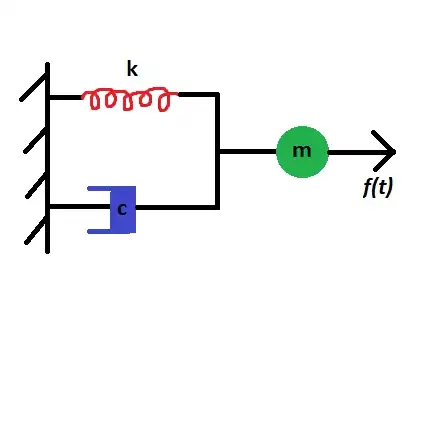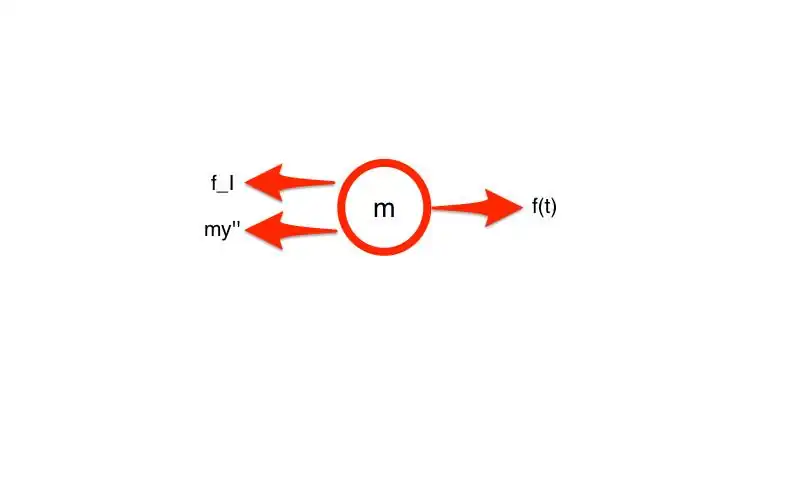University of Florida/Egm4313/IEA-f13-team10/R1
Report 1
Problem 1.1
Problem Statement
Derive the equation of motion of a spring-dashpot system in parallel with a mass and applied force.
Solution

Kinematics
The spring and dashpot are in parallel, so the displacement of the spring is equal to the displacement of the dashpot.
(1)
Kinetics
(2)
(3)
Constitutive Relations
(4)
(5)
From (2), (3), (4) and (5), the equation of motion for the system is
From the first and second derivatives of (1),
So in terms of the displacement of the mass, the final equation of motion is,
Honor Pledge
On our honor, we did this problem on our own, without looking at the solutions in previous semesters or other online solutions.
Problem 1.2
Problem Statement
Derive the equation of motion of the springmass-
dashpot in Fig.53, in K 2011 p.85, with
an applied force r(t) on the ball.
Solution
Kinematics
The displacement of the spring equals the negative displacement of the dashpot (constitutive relation)
Kinetics
Newton's second law
Substituting the relation above and kinematics section into the kinetics part, we get the equation of motion
Using the constitutive relations shown above we can write the equation of motion as
Honor Pledge
On our honor, we did this problem on our own, without looking at the solutions in previous semesters or other online solutions.
Problem 1.3
Problem Statement
For the spring-dashpot-mass system on p.1-4, draw the FBDs and derive the equation of motion (2) p.1-4.
Solution
Step 1, Kinematics
, therefore and
Step 2, FBD and Kinetics

Step 3, Relations
Step 4
, therefore , and and
Step 5
Plugging the last equation from step 4 into the last equation from step 1,
Step 6
Plugging the equation from step 5 into the first kinetic equation as y",
Honor Pledge
On our honor, we did this problem on our own, without looking at the solutions in previous semesters or other online solutions.
Problem 2.1
Problem Statement
Derive (3) and (4) from (2).
(2)
(3)
(4)
Solution
Derivation of (3) from (2)
(A)
(B)
Using equation A, we can show that and
Using equation B, we can show that
After these transformations, the new equation 2 is
Taking the derivative of both sides of equation 2, we get
Derivation of (4) from (2)
Using equation B, we can show that and and
After these transformations, the new equation 2 is
Honor Pledge
On our honor, we did this problem on our own, without looking at the solutions in previous semesters or other online solutions.
Problem 1.5
K 2011 p.59 pbs 3,12
Problem Statement
Find a general solution.
Solution
Problem 3
This is a linear, first order ODE with constant coefficients.
To find the general solution to this ODE set
so that and
Substituting in y to the ODE and factoring out we get:
Using the quadratic formula to solve for r we get
where a = 1, b = 6, and c = 8.96
Solving to get r = -3.2 and r = -2.8
We get the general solution
Now with the initial values y(0) = 1 and y'(0) = .5
,
Problem 12
y′′+9 y′+20y=0
This is a linear, first order ODE with constant coefficients.
To find the general solution to this ODE set
so that and
Substituting in y to the ODE and factoring out we get:
Using the quadratic formula to solve for r we get
where a = 1, b = 9, and c = 20
Solving to get r = -5 and r = -4
We get the general solution
Now with the initial values y(0) = 1 and y'(0) = .5
,
Honor Pledge
On our honor, we did this problem on our own, without looking at the solutions in previous semesters or other online solutions.
Problem 2.3
K 2011 p.3 Fig.2
Problem Statement
For each ODE in Fig. 2 (except for the last one), determine the order; determine if it is linear; and show whether the principle of superposition can be applied.
Solution
Falling stone
(1)
Equation (1) is the ODE that describes the acceleration of the stone as it falls from some height to the ground.
The highest order derivative of the dependent variable in an ODE determines the order of the ODE. In (1) the highest order derivative of the dependent variable y is second order. So (1) is a second-order ODE.
"A second-order ODE is called linear if it can be written " (Kreyszig 2011, p.46). Since (1) is in this form, with p(x) and q(x) = 0 and r(x) = g, then (1) is a linear ODE.
If the principle of superposition applies, then a solution , which is comprised of the sum of the homogeneous solution
and the particular solution , should satisfy the original ODE. So if superposition applies,
(2) .
To determine whether superposition applies to (1), we consider
.
Now, using (2) and the linearity of the derivative,
.
satisfies (1), so superposition can be applied.
Parachutist
(3)
Since v' is the highest order derivative of the dependent variable v, (3) is a first-order ODE.
Because the dependent variable v is squared, (3) is a non-linear ODE.
D(w+y) does not equal f(w) + f(y) thus it is not linear.
Rearranging (3) we obtain
.
The homogeneous solution of the ODE is
.
The particular solution of the ODE is
.
Using (2) and the linearity of the derivative we obtain
but
Therefore, is not a solution to the ODE. So superposition cannot be applied.
Outflowing water
(4)
(4) is a first-order ODE because of h' .
(4) is a non-linear ODE because of the square-rooted dependent variable h.
D(y+w) does not equal f(w)+f(y) so it is non-linear.
Rearranging (4) we obtain .
Summing the homogeneous and particular solutions we obtain .
But .
So is not a solution to (4), and superposition cannot be applied.
Vibrating mass on a spring
(5)
(5) is a second-order linear ODE.
satisfies (5), so superposition can be applied.
Beats of a vibrating system
(6)
(6) is a second-order linear ODE. Even with the and terms, (6) is still linear because these are functions of the independent variable. We only look at the dependent variable when determining the linearity of an ODE.
satisfies (6), so superposition can be applied.
Current I in an RLC circuit
(7)
(7) is a second-order linear ODE.
satisfies (7), so superposition can be applied.
Deformation of a beam
(8)
(8) is a fourth-order linear ODE.
satisfies (8), so superposition can be applied.
Pendulum
(9)
(9) is a second-order non-linear ODE.
But
Therefore is not a solution to (9), and superposition does not apply.
Honor Pledge
On our honor, we did this problem on our own, without looking at the solutions in previous semesters or other online solutions.